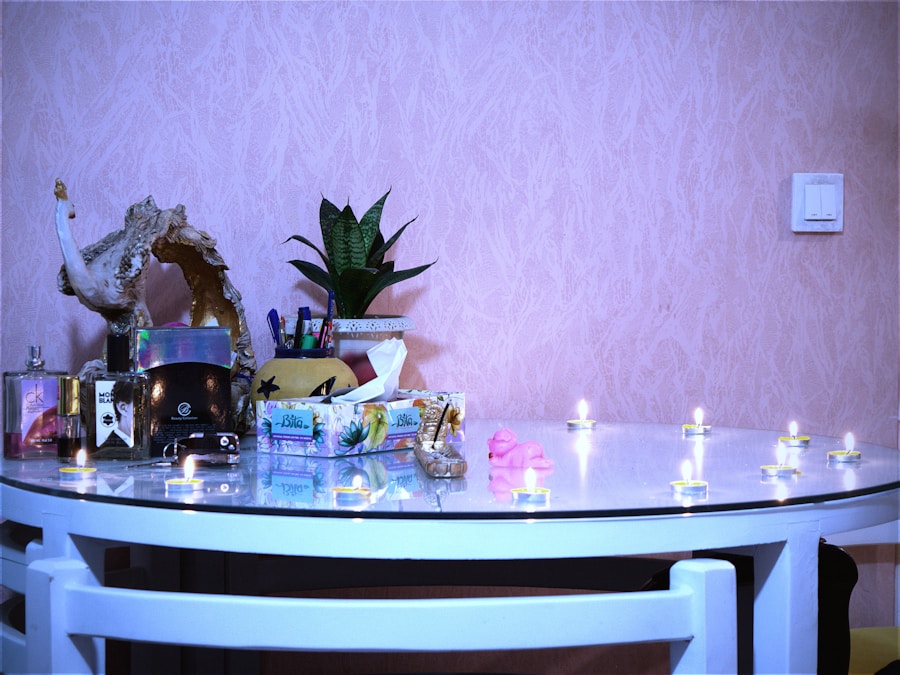The receptionist desk serves as the frontline of any organization, acting as the first point of contact for visitors, clients, and employees alike. Its importance cannot be overstated; it is where initial impressions are formed, and these impressions can significantly influence a visitor’s perception of the company. A welcoming receptionist desk conveys professionalism, warmth, and efficiency, setting the tone for the entire experience.
When visitors are greeted with a friendly smile and a warm welcome, they are more likely to feel comfortable and valued, which can lead to positive interactions and long-term relationships. Moreover, the receptionist desk plays a crucial role in managing the flow of information within an organization. It is not merely a physical space; it is a hub of communication where inquiries are addressed, appointments are scheduled, and messages are relayed.
A well-organized and inviting reception area can enhance operational efficiency by ensuring that visitors are directed to the right person or department promptly. This efficiency not only reflects well on the organization but also contributes to a smoother experience for everyone involved.
Key Takeaways
- A welcoming receptionist desk is crucial for creating a positive first impression for visitors and setting the tone for their experience with your company.
- Designing a functional and inviting reception area can help create a warm and professional atmosphere for visitors and employees alike.
- Training and empowering receptionists with hospitality and customer service skills is essential for ensuring a positive experience for visitors and guests.
- Utilizing technology such as digital sign-in systems and communication tools can enhance the efficiency and effectiveness of the receptionist desk.
- Implementing hospitality and customer service skills at the receptionist desk can help create a welcoming and accommodating environment for visitors.
Designing a Functional and Inviting Reception Area
Optimizing Layout and Desk Placement
The layout should facilitate easy movement for both visitors and staff while ensuring that the receptionist can effectively manage their duties. A well-placed desk allows for unobstructed sightlines, enabling the receptionist to monitor the entrance and greet guests as they arrive.
Creating a Comfortable Waiting Area
Incorporating comfortable seating arrangements can make waiting times more pleasant, encouraging visitors to feel at ease while they wait for their appointments.
Reflecting Brand Identity through Aesthetics
Aesthetics also play a significant role in the design of a reception area. The choice of colors, furniture, and decor should reflect the company’s brand identity and values. For instance, a tech startup might opt for modern furniture with sleek lines and vibrant colors to convey innovation and creativity, while a law firm may choose classic furnishings in muted tones to project professionalism and trustworthiness. Incorporating elements such as artwork or plants can further enhance the ambiance, making the space feel more welcoming and less sterile.
Training and Empowering Receptionists

The effectiveness of a receptionist desk is heavily reliant on the skills and demeanor of the receptionist themselves. Therefore, investing in comprehensive training programs is essential. Receptionists should be well-versed in company policies, procedures, and services to provide accurate information to visitors.
Training should also encompass communication skills, conflict resolution, and customer service techniques to ensure that receptionists can handle various situations with poise and professionalism. Empowering receptionists goes beyond just training; it involves instilling confidence in them to make decisions that benefit both the visitor and the organization. For example, if a visitor arrives without an appointment but has an urgent matter, a well-trained receptionist should feel empowered to facilitate a meeting or direct them to someone who can assist them.
This level of autonomy not only enhances the visitor’s experience but also fosters a sense of ownership among receptionists, leading to higher job satisfaction and performance.
Utilizing Technology to Enhance the Receptionist Desk
In today’s digital age, technology plays an integral role in enhancing the efficiency of the receptionist desk. Implementing visitor management systems can streamline check-in processes, allowing guests to sign in electronically rather than using paper logs. This not only saves time but also improves security by maintaining accurate records of who is in the building at any given time.
Additionally, digital displays can provide real-time information about appointments or events happening within the organization, keeping visitors informed and engaged. Moreover, integrating communication tools such as instant messaging or video conferencing can facilitate quicker responses to inquiries. For instance, if a visitor has a question about their appointment or needs assistance finding a specific department, receptionists can quickly connect with colleagues through these tools rather than relying solely on phone calls or in-person communication.
This technological integration not only enhances operational efficiency but also allows receptionists to provide a higher level of service to visitors.
Implementing Hospitality and Customer Service Skills
The essence of a successful receptionist desk lies in its ability to deliver exceptional hospitality and customer service. Receptionists should be trained to adopt a service-oriented mindset, viewing each interaction as an opportunity to create a positive experience for visitors. This involves active listening skills, where receptionists attentively hear out visitors’ needs or concerns before responding appropriately.
By demonstrating genuine interest in helping others, receptionists can build rapport with visitors from the moment they walk through the door. Additionally, employing techniques such as positive language and empathy can significantly enhance interactions at the receptionist desk. For example, instead of saying “I don’t know,” a receptionist might say, “Let me find out that information for you.” Such phrasing not only conveys willingness to assist but also reassures visitors that their needs are being prioritized.
Training programs should emphasize these soft skills alongside technical knowledge to create well-rounded receptionists who embody the values of hospitality and customer service.
Maintaining a Clean and Organized Reception Area

Establishing a Cleaning Schedule
Regular cleaning schedules should be put in place to ensure that surfaces are wiped down, floors are kept tidy, and seating areas are free from debris.
Organizing Materials and Information
Organizing materials such as brochures or business cards in an orderly fashion can enhance accessibility for both receptionists and visitors. Moreover, implementing filing systems for documents or utilizing digital tools for scheduling can help maintain orderliness in daily operations.
The Benefits of a Well-Organized Reception Area
A well-organized reception area not only improves efficiency but also reflects positively on the company’s image, demonstrating that it values professionalism and care in all aspects of its operations.
Personalizing the Receptionist Desk for Your Company
Personalization is key to making a receptionist desk feel unique and reflective of the company’s culture. This can be achieved through branding elements such as logos displayed prominently on signage or promotional materials available in the reception area. Additionally, incorporating colors that align with the company’s branding can create a cohesive look that resonates with visitors.
Furthermore, personal touches such as showcasing employee achievements or community involvement can foster a sense of connection between visitors and the organization. For instance, displaying awards or certificates on the wall can highlight the company’s accomplishments while also instilling pride among employees. Personalization not only enhances the aesthetic appeal of the reception area but also communicates the company’s values and mission effectively.
Creating a Positive First Impression for Visitors
The first impression formed at the receptionist desk can have lasting effects on how visitors perceive an organization. A warm greeting combined with attentive service sets a positive tone for their entire visit. Receptionists should be trained to maintain eye contact, smile genuinely, and use welcoming language when interacting with guests.
These small gestures contribute significantly to creating an inviting atmosphere that encourages open communication. Moreover, ensuring that visitors feel valued extends beyond just initial greetings; it involves providing timely assistance throughout their visit. Whether it’s offering refreshments while they wait or proactively checking in on their needs during their stay, these actions reinforce a culture of hospitality that leaves a lasting impression.
By prioritizing visitor experience at every touchpoint, organizations can cultivate strong relationships that lead to repeat business and positive word-of-mouth referrals.
If you are looking to create a comfortable and ergonomic workspace, consider investing in a height-adjustable desk. This type of desk can help improve your posture and reduce the risk of musculoskeletal issues. To learn more about the benefits of height-adjustable desks, check out this article on height-adjustable desks. Additionally, ensuring that your workstation is set up correctly is crucial for your health and safety. For tips on how to optimize your workstation for better health and safety, read this informative article on workstation health and safety.
FAQs
What is a receptionist desk?
A receptionist desk is a piece of furniture typically located in the entrance or lobby area of a business or organization. It is where the receptionist sits and performs various administrative tasks such as greeting visitors, answering phones, and managing appointments.
What are the common features of a receptionist desk?
Common features of a receptionist desk include a work surface for the receptionist to work on, storage drawers or shelves for organizing paperwork and office supplies, and a counter or ledge for interacting with visitors.
What materials are receptionist desks typically made of?
Receptionist desks are typically made of wood, metal, or a combination of both. They may also feature glass or laminate surfaces for a modern look.
What are the different styles of receptionist desks?
Receptionist desks come in a variety of styles, including traditional, modern, and contemporary designs. They may also vary in size and configuration to accommodate different office layouts and space constraints.
What factors should be considered when choosing a receptionist desk?
When choosing a receptionist desk, factors to consider include the size of the reception area, the functional needs of the receptionist, the overall aesthetic of the office, and the budget for purchasing the desk.
Are there specialized receptionist desks for specific industries?
Yes, there are specialized receptionist desks designed for specific industries such as healthcare, hospitality, and retail. These desks may have features tailored to the unique needs of the industry, such as built-in storage for medical records in a healthcare setting or a display area for merchandise in a retail environment.


